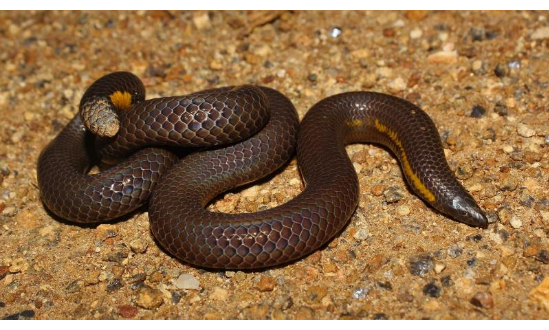Researchers from the Sálim Ali Centre for Ornithology and Natural History Coimbatore, and the Natural History Museum, London, UK, discover a new species of shieldtail snake, Uropeltis bhupathyi, from the Anaikatty Hills in Coimbatore, Tamil Nadu. Shieldtail snakes belong to the Uropeltidae family of snakes that has over 50 species.
Coimbatore, Tamil Nadu (ISJ) – Researchers from the Sálim Ali Centre for Ornithology and Natural History (SACON), Coimbatore, and the Natural History Museum (NHM), London, UK, have discovered a new species of shieldtail snake, Uropeltis bhupathyi, from the Anaikatty Hills in Coimbatore, Tamil Nadu.
Shieldtail snakes belong to the Uropeltidae family of snakes that has over 50 species. They get their name from a keratinous shield at the tip of their tail. They are non-venomous, borrowing snakes found only in India and Sri Lanka. So far, not much is known regarding the diversity, biology, and natural history of many of these species.
The newly discovered species, Uropeltis bhupathyi, is described in an article in the journal Zootaxa. It is about 27-39 cm long and has a blackish-brown body with iridescent scales on the top, and a greyish underside and a moderate tail shield. It is named after Dr. Subramanian Bhupathy, a noted Indian herpetologist, to honour his remarkable contribution in the field of herpetology. As the specimens of U. bhupathyi were collected from the SACON campus, the authors have aptly suggested its common names to be Bhupathy’s uropeltis or Bhupathy’s shieldtail.
“During my PhD, I often came across a few species of Uropeltid snakes in field, which are taxonomically not characterised well, and would take photographs to get a closer look at the morphological features. I was intrigued when one species from SACON campus (earlier reported as U.ellioti) looked similar to U. elliotiin their colour patterns but differed in the number of scales in their belly. While U. ellioti has about 167 belly scales, these unidentified snakes had more than 200. The species also differed in the shape and size of their head-scales,” said Dr. V. J Jins, the lead author of the study.
Soon after, Dr. Jins had the opportunity to work on the taxonomy of uropeltid snakes of the Western Ghats under the supervision of Dr. David, who specialises in burrowing snakes’ taxonomy, at NHM, London.
“We compared specimens of different species of uropeltids in the museum and came to the conclusion that the species I had photographed from the Anaikatty Hills could be a different one,” said Dr. Jins.
The researchers then undertook field surveys, analysed the specimens and compared with those in the museum. They found that the observed sample in the study had 17 dorsal scales on the top and 202-220 ventral scales below. Like other shieldtail snakes, individuals of U. bhupathyi were non-aggressive, did not try to bite if picked up and curled merely around the hand. While these snakes usually remained buried in the soil, the researchers observed during the mornings or rainy weather, they ventured out.
The researchers believe that there is more to be done before understanding the distribution of the new species. “Since we have not conducted any extensive surveys (digging or systematic sampling) in the present study, an intensive sampling strategy exploring the whole Anaikatty Hills including protected area network would be beneficial to understand their population status,” said Dr Jins.
Like many other species of the Western Ghats, U. bhupathyi also faces specific threats such as habitat modification due to the exploitation of soil by brick industries, roadkills, and diseases similar to the potentially lethal snake fungal disease. “However, the new species seems to be locally widespread, and we expect to find a good population inside the protected areas of Nilgiri Biosphere Reserve,” said Dr Jins with optimism.
The discoveries of species in the Western Ghats add to the body of knowledge about our country’s biodiversity that has been unexplored post-independence. “Most of the taxonomic work in Indian herpetofauna (amphibians and reptiles) is of the colonial period. After the 19th century, there are not much taxonomic activities in reptiles of the Western Ghats,” remarked Dr. Jins. India is home to about 270 species of snakes, out of which about 60 are highly venomous.


